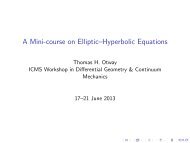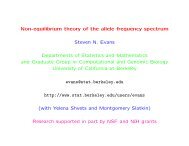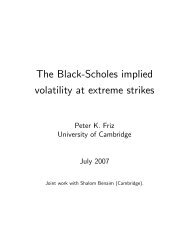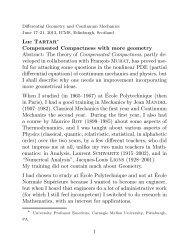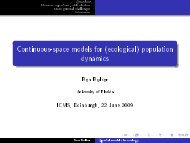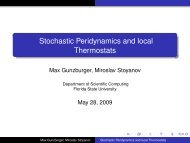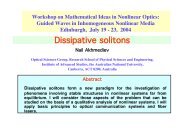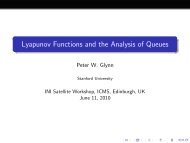1. Introduction We are going to investigate the equation ut(t, x ... - ICMS
1. Introduction We are going to investigate the equation ut(t, x ... - ICMS
1. Introduction We are going to investigate the equation ut(t, x ... - ICMS
- No tags were found...
You also want an ePaper? Increase the reach of your titles
YUMPU automatically turns print PDFs into web optimized ePapers that Google loves.
22in our range of θ.<strong>the</strong>orem forTherefore, instead of consideringĀ = M∆ ˜RM −1 f.Ã we may and will prove <strong>the</strong>Notice that, if f ∈ C ∞ 0 (R × Rd ) and t is not in <strong>the</strong> support of f(s) as a function of s,<strong>the</strong>n ˜T s,t M −1 f(s) is infinitely differentiable in x andĀf(t) =M∆ ˜RM −1 f(t) =∫ t−∞M∆ ˜T s,t M −1 f(s) ds. (5.3)Moreover, <strong>the</strong> boundedness of Ā as an opera<strong>to</strong>r from L p (R,H γ p,θ ) <strong>to</strong> L p(R,H γ p,θ ) andpoinwise estimates of <strong>the</strong> opera<strong>to</strong>r M∆ ˜T s,t M −1 show that (5.3) holds for almost all <strong>to</strong><strong>ut</strong>side <strong>the</strong> support of f if f is a bounded H γ p,θ-valued function with compact support.In o<strong>the</strong>r words, for those t,∫Āf(t) =RK(t, s)f(s) ds,where <strong>the</strong> opera<strong>to</strong>r K(t, s) is defined by <strong>the</strong> formulaK(t, s)h = I t>s M∆ ˜T s,t M −1 h.Observe that by a general <strong>the</strong>orem, K(t, s) is a bounded opera<strong>to</strong>r from H γ p,θin<strong>to</strong> itselfwith norm less than N|t − s| −1 .




